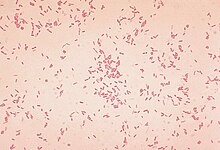Aeromonas hydrophila
| Aeromonas hydrophila | |
|---|---|
 |
|
| Scientific classification | |
| Domain: | Bacteria |
| Phylum: | Proteobacteria |
| Class: | Gammaproteobacteria |
| Order: | Aeromonadales |
| Family: | Aeromonadaceae |
| Genus: | Aeromonas |
| Species: | A. hydrophila |
| Binomial name | |
|
Aeromonas hydrophila (Chester, 1901) Stanier, 1943 |
|
| Synonyms | |
|
Bacillus hydrophilus fuscus Sanarelli 1871 |
|
Bacillus hydrophilus fuscus Sanarelli 1871
Bacillus hydrophilus Chester 1901
Proteus hydrophilus (Chester 1901) Bergey et al. 1923
Bacterium hydrophilum (Chester 1901) Weldin and Levine 1923
Pseudomonas hydrophila (Chester 1901) Breed et al. 1948
Aeromonas hydrophila is a heterotrophic, Gram-negative, rod-shaped bacterium mainly found in areas with a warm climate. This bacterium can be found in fresh or brackish water. It can survive in and anaerobic environments, and can digest materials such as gelatin and hemoglobin. A. hydrophila was isolated from humans and animals in the 1950s. It is the most well known of the species of Aeromonas. It is resistant to most common antibiotics and cold temperatures and is oxidase and indole positive.
A. hydrophila bacteria are Gram-negative, straight rods with rounded ends (bacilli to coccibacilli shape) usually from 0.3 to 1.0 μm in width, and 1.0 to 3.0 μm in length. They can grow at temperatures as low as 4 °C. These bacteria are motile by a polar flagellum.
Because of its structure, it is very toxic to many organisms. When it enters the body of its victim, it travels through the bloodstream to the first available organ. It produces aerolysin cytotoxic enterotoxin that can cause tissue damage. A. hydrophila, A. caviae, and A. sobria are all considered to be opportunistic pathogens, meaning they rarely infect healthy individuals. A. hydrophila is widely considered a major fish and amphibian pathogen, and its pathogenicity in humans has been recognized for decades. The genomic insights of aeromonads could be a stepping stone into understanding of them
The pathogenicity of Aeromonas species was believed to be mediated by a number of extracellular proteins such as aerolysin, lipase, chitinase, amylase, gelatinase, hemolysins, and enterotoxins. However, the pathogenic mechanisms are unknown. The recently proposed type-III secretion system (TTSS) has been linked to Aeromonas pathogenesis. TTSS is a specialized protein secretion machinery that exports virulence factors directly to host cells. These factors subvert normal host cell functions to the benefit of invading bacteria. In contrast to the general secretory pathway, the TTSS is triggered when a pathogen comes in contact with host cells. ADP-ribosylation toxin is one of the effector molecules secreted by several pathogenic bacteria and translocated through the TTSS and delivered into the host cytoplasm, which leads to interruption of the NF-κB pathway, cytoskeletal damage, and apoptosis. This toxin has been characterized in A. hydrophila (human diarrhoeal isolate), A. salmonicida (fish pathogen), and A. jandaei GV17, a pathogenic strain which can cause disease both in humans and fish.
...
Wikipedia
